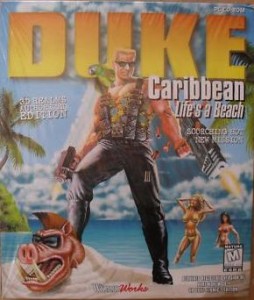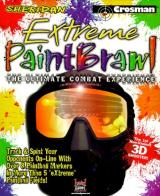The History of Duke Nukem – Part Four: Making It Your Way
by Matt Keller on Jun.06, 2011, under Specials
When the full version of Duke Nukem 3D shipped in May 1996, the Build level editor was included on the disc. This was the exact same editor that was used to make the levels included in the game. The editor was easy to use and well documented – anyone, regardless of experience, could assemble a basic level in Build. Tools were included that could port levels and textures from Doom, meaning that user-created levels were available almost overnight.
Communities of Duke 3D level builders sprung up quickly too. Within weeks of release, people were trading levels, writing tutorials on the more advanced aspects of the editor, and adding new textures for use with the game. Some of the best level creators found themselves being scouted by professional development studios – Valve Software’s Aaron Barber and Matt T. Wood were originally hired by Xatrix Entertainment and 3D Realms respectively based on their work with the Build engine.
| The Best of the Bunch
These maps are considered the best available on the Duke Nukem Repository, with a score of 99/100. Some of these maps require the newest versions of mods, so read the instructions before downloading. Blown Fuses |
Level Packs
When Duke Nukem 3D’s popularity was at its peak, budget publisher WizardWorks produced a number of retail packages of user made levels. The first pack, DukeZone! contained over 500 (mainly Dukematch focused) user made levels for the game. It was followed up by DukeZone II, which featured the same 500 levels in addition to four episodes of single player levels created by the team at WizardWorks. The final pack, Duke Assault, assembles some 1,500 user created levels. While the packs were cheap, fans generally derided the quality of the levels that were contained within. Due to low print runs and perceived low value at the time, the WizardWorks packs are now prized by Duke collectors.
WizardWorks later joined forces with Simply Silly Software to create the add-on Duke Nukem: Nuclear Winter. This add-on takes Duke to the North Pole, where he must rescue Santa Claus, who has been brain-washed by aliens into causing trouble on Christmas Day. The pack was generally derided by fans due to its silly theme, but it is sought after by collectors.
Another developer, Sunstorm Interactive also produced a series of themed level packs for Duke 3D. The first, Duke it out in DC, had Duke rescuing President Clinton, who had been kidnapped by aliens. The add-on included a whole bunch of real-life locations from Washington D.C., including the Washington Monument, the White House, the FBI and the Smithsonian Museum.
 |
 |
 |
The DC add-on wasn’t authorised by 3D Realms, but it drew their attention and lead to the studio giving their authorisation of Sunstorm’s other Duke 3D expansions, along with a deal to produce add-ons for Shadow Warrior. Charlie Wiederhold, who designed a number of maps for the Sunstorm map packs, ended up working at 3D Realms on Duke Nukem Forever.
Sunstorm’s second expansion was Duke Caribbean: Life’s a Beach. Duke is on vacation in the Caribbean, when he discovers that the alien menace is also enjoying the sights. As the title suggests, the add-on features a tropical vacation theme, with many of the levels involving hotels, resorts and tourist traps. The other Sunstorm add-on is Duke Xtreme, a pack which contains 50 levels designed by the team in addition to some tools for user made levels.
Duke it out in DC, Duke Xtreme and DukeZone II were included in the Duke Nukem: Kill-A-Ton Collection, which also included Duke Nukem, Duke Nukem II, Duke Nukem 3D: Atomic Edition, the GameWizards interactive play guide and desktop themes for Windows 95. Duke Zone II and Duke Xtreme were compiled in the Duke: The Apocalypse pack, which also included a t-shirt.
Unofficial level packs also came from Sierra On-Line (Total Meltdown, 500 levels) and Crystal Vision (Nuke It 1000, 1000 levels), Most Significant Bits (Duke 3D Mania, 700 single player levels) and Micro Star (Nuke It and Nuke It V2). The original Nuke It pack was disallowed by FormGen until Micro Star worked out a deal with the company.
The Build Engine Legacy
Apogee was quite active in licensing the Build engine technology. In fact, the first games using the Build tech, Witchaven and TekWar, came out in 1995 – some months before Duke Nukem 3D launched. A dozen other commercial releases utilised the Build engine.
 |
Witchaven (1995, Capstone Software, DOS) Witchaven is a melee focused first person shooter with light RPG elements and a sword and sorcery theme. Players take on the role of Grondoval, a knight chosen to venture the island of Witchaven to defeat the evil witch Illwhyrin, who has plunged the land into darkness. First person melee combat was somewhat novel at the time, but Witchaven didn’t do it very well. The game earned some praise for its character sprites, which were actually clay sculptures made for the game, but was generally written off due to dull level design and terrible AI. |
 |
TekWar (1995, Capstone Software, DOS) TekWar was a series of sci-fi novels written by William Shatner in his post Star Trek, pre Boston Legal days. The series was picked up for a television adaptation in 1995, and this game was spun off from that. You play an ex-cop who was put into cryosleep and hired as a hitman when you were woken. Your target is the Teklords, a group of seven people who are responsible for the distribution of a deadly, addictive new drug called Tek. Shatner is the only actor from the TV series to reprise his role. The game features interesting level design and some cool weapons, but most people remember it for its shrilling civilians begging for their lives, rather than the gameplay itself. |
 |
Witchaven II: Blood Vengeance (1996, Capstone Software, DOS) Witchaven II picks up where the first game left off, with one of the evil witch Illwhyrin’s sisters swearing vengeance upon your people – and promptly reaping it. You get to wander back to the land of Witchaven to kick her ass. The game is very similar to the first – some reviews at the time even wrote it off as a glorified expansion pack. It does, however, come with the Build editor, so you can make your own levels. |
 |
Powerslave/Exhumed (1996, Lobotomy Software, DOS) Powerslave was originally in development at 3D Realms under the title of Ruins: Return of the Gods, but the title was dropped to focus resources on Duke Nukem 3D. It’s an Egyptian themed first person shooter, where players are guided by the spirit of Ramses in their quest to save the city of Karnak. The PC version of the game uses the Build engine, while the console versions were built on Lobotomy’s SlaveDriver engine. The differences between the two versions are more than just cosmetic, however. |
 |
Shadow Warrior (1997, 3D Realms, DOS) Shadow Warrior had been revealed before Duke Nukem 3D, but ended up coming out much later after 3D Realms shifted its focus to Duke. Players control Lo Wang, an assassin who has turned against his former masters. It was the first game to see some major enhancements to the Build engine including limited 3DFX support, voxel support and room-over-room sectors. Shadow Warrior had other cool features like driveable vehicles, portable nukes and sticky bombs. Two retail expansions to the game were planned but cancelled. One expansion, Wanton Destruction, was eventually released for free in 2005. The other, Deadly Kiss, has never surfaced. |
 |
Blood (1997, Monolith Software, DOS) Blood was originally under development at 3D Realms, but was sold so the company could focus on Shadow Warrior. Monolith finished the game’s development and released it in mid 1997. Players control Caleb, a former commander of a cult called the Cabal, who worshipped the god Tchernobog. Caleb was betrayed and murdered by the god, and seeks revenge after being resurrected. Blood is arguably the best of the Build engine games after Duke Nukem 3D, with its combination of scary atmosphere, great level design and challenging gameplay putting it above the rest. Blood had two expansions – Cryptic Passage from Sunstorm Interactive and Plasma Pak from Monolith. |
 |
Redneck Rampage (1997, Xatrix Entertainment, DOS) Redneck Rampage was produced by Xatrix Entertainment, and is meant to be a send up of redneck life. The player controls two rednecks named Leonard and Bubba, who are reaping revenge on aliens that kidnapped their prized pig. The game involves doing everything stereotypical rednecks do: drinking stuff and shooting stuff. It’s not the best of the Build games, but it does have some novelty value – I believe it might be the first FPS where players can get drunk. Sunstorm Interactive released an expansion pack for the game called Suckin’ Grits on Route 66, which involves Leonard and Bubba going on vacation. |
 |
Redneck Deer Huntin’ (1997, Xatrix Entertainment, DOS) After the success of Sunstorm Interactive’s Deer Hunter, Xatrix decided to parody the hunting game concept using the characters from Redneck Rampage. The result was pretty damn awful, but so was Deer Hunter. |
 |
Redneck Rampage Rides Again (1998, Xatrix Entertainment, DOS) Set directly after the end of the first game, Redneck Rampage Rides Again follows Leonard and Bubba as they try to make their way back to Hickston after crashing the UFO they stole. It’s more of a standalone expansion pack as opposed to a sequel, as very little in the way of new content or features were added to the game. |
 |
Extreme Paintbrawl (1998, Creative Carnage, Windows 98) It’s exactly what it says on the tin – a first person shooter based on the sport of paintball which utilises the Build engine. Produced on a budget that wouldn’t cover a week’s worth of coffee, it’s one of the worst rated games of all time with an average press score of just 13/100. |
 |
NAM/Napalm (1998, TNT Team, DOS) NAM is an extremely low budget war-based first person shooter, released at a time when just about every new first person shooter was releasing on full 3D engines complete with 3DFX/Direct 3D/Open GL support and online multiplayer capabilities. NAM was build directly on top of Duke Nukem 3D, acting as more of a total conversion mod as opposed to a full game. It uses many of the same sound effects, CON files and even animations (like knuckle cracking at the start of a level). The game was poorly received. |
 |
WWII GI (1999, TNT Team, DOS) Released a year after NAM, WWII GI is essentially another glorified total conversion mod, but it actually adds a few new bells and whistles into the mix. The problem was that by the time the game released in March of 1999, the second generation of full 3D first person shooters – Half-Life, SiN and Unreal – had been released. WWII GI was the final Build engine game released at retail. |
Legend of the Seven Paladins, Fate and Corridor 8: Galactic Warriors were based on the Build engine but were not released.
Mod it
Ken Silverman released the complete Build engine source code to the public in June 2000. Several modders began projects using the source code. Two of the most popular projects were EDuke, a project to make Duke 3D modding simpler, and mapster, a more powerful and user friendly map editor. Many of these projects were held back by the fact that the Duke Nukem 3D source code was still private – EDuke was sent to 3D Realms for packaging, but they found that they were using older Build engine libraries than the ones released to the public.
3D Realms decided to release the Duke Nukem 3D source code on April 1, 2003. Within days, Ryan C. “icculus†Gordon and Jonathon “JonoF†Fowler began work on major source ports for the game, bringing it to Linux and Windows. Ken Silverman decided to update the Build engine with an OpenGL renderer after seeing that nobody else had. The Polymost renderer allowed for 3D accelerated graphics and replacement of the original textures with high definition ones. Silverman worked with JonoF to implement the Polymost renderer in JFDuke and other projects.
After the release of the source code for EDuke 2.0, many of the separate Duke 3D source code projects were merged. Richard “TerminX†Gobielle, author of mapster, brought a bunch of these different source projects together to make EDuke32. EDuke32 allows for high resolution, OpenGL graphics, greater stability, real time dynamic lighting and shadows, coloured fog and a whole variety of other features. Its easy scripting allows for extensions to be added painlessly. One of the most popular extensions is the High Resolution Pack, which adds high resolution textures, full 3D models and a variety of new effects.
| Duke Nukem 3D: Reloaded
Duke Nukem 3D: Reloaded is a reimagining of the game being developed by Interceptor Entertainment. Reloaded has been granted a non-commercial license by Gearbox Software to produce the game, and Jon St. John will be re-recording his lines from the original game. The team is aiming to produce a modern interpretation of the original game that still maintains the “Duke Feelâ€. It is being created on Unreal Engine 3. A multiplayer version is expected to release first, with the single player side of the game following that. No release date has been revealed as yet. |
| < Back to Part Three: Duke Nukem 3D | Continue to Part Five: The Journey to Forever > |
Leave a Reply
You must be logged in to post a comment.




